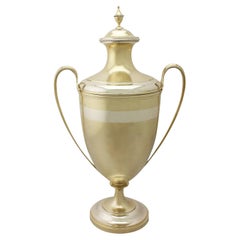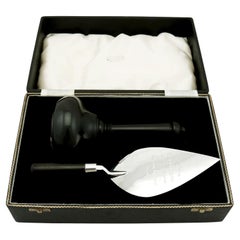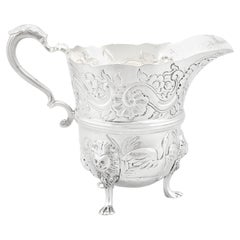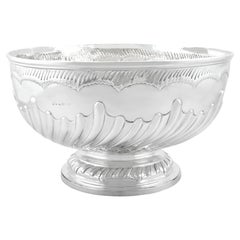Video Loading
Want more images or videos?
Request additional images or videos from the seller
1 of 12
19th Century Victorian Sterling Silver Presentation Trowel, Circa 1850
$1,954.19List Price
About the Item
- Creator:Francis Higgins II (Maker)
- Dimensions:Height: 2.13 in (5.4 cm)Width: 4.14 in (10.5 cm)Depth: 13.12 in (33.3 cm)
- Style:Victorian (Of the Period)
- Materials and Techniques:
- Place of Origin:
- Period:
- Date of Manufacture:1856
- Condition:Please see main description.
- Seller Location:Jesmond, GB
- Reference Number:Seller: A83801stDibs: LU120028582313
About the Seller
5.0
Recognized Seller
These prestigious sellers are industry leaders and represent the highest echelon for item quality and design.
Established in 1977
1stDibs seller since 2015
721 sales on 1stDibs
Typical response time: 13 hours
Associations
LAPADA - The Association of Arts & Antiques DealersInternational Confederation of Art and Antique Dealers' Associations
Authenticity Guarantee
In the unlikely event there’s an issue with an item’s authenticity, contact us within 1 year for a full refund. DetailsMoney-Back Guarantee
If your item is not as described, is damaged in transit, or does not arrive, contact us within 7 days for a full refund. Details24-Hour Cancellation
You have a 24-hour grace period in which to reconsider your purchase, with no questions asked.Vetted Professional Sellers
Our world-class sellers must adhere to strict standards for service and quality, maintaining the integrity of our listings.Price-Match Guarantee
If you find that a seller listed the same item for a lower price elsewhere, we’ll match it.Trusted Global Delivery
Our best-in-class carrier network provides specialized shipping options worldwide, including custom delivery.You May Also Like
19th Century Victorian Solid Silver Presentation Shovel, Barnard, c.1892
By Walter and John Barnard
Located in Royal Tunbridge Wells, Kent
Antique 19th century Victorian solid silver presentation shovel, exceptionally large, the solid silver blade is engraved "Presented to Mrs Theobald, by the workmen of St Cuthbert's L...
Category
Antique 19th Century English Victorian Sterling Silver
Materials
Silver
$3,430
Free Shipping
H 28.35 in W 5.12 in D 1.97 in
Large Victorian Sterling Silver Presentation Jug
By Robert Hennell III
Located in London, GB
An impressive silver beer jug with high-relief, chased scenes of a stag hunt among scrolling foliage and floral designs. This substantial piece, made by a fine silversmith, has a cas...
Category
Antique 1840s English Victorian Sterling Silver
Materials
Sterling Silver
$13,747 Sale Price
20% Off
H 14.75 in W 11 in D 8.5 in
19th Century Victorian Sterling Silver Butter Dish with Cow Finial
By Edward Charles Brown 1
Located in London, London
Hallmarked in London in 1867 by Edward Charles Brown, this charming, Victorian, Antique, Sterling Silver Butter Dish, features engr...
Category
Antique 1860s English Victorian Sterling Silver
Materials
Sterling Silver
$2,577
H 4.93 in W 7.09 in D 7.09 in
Large 19th Century Sterling Silver Serving Water Pitcher / Victorian Style
Located in Tarry Town, NY
Behold the resplendent beauty of this magnificent 19th century victorian style Black Starr Forest sterling silver tableware water pitcher. Immerse yourself in the opulent of a bygon...
Category
Antique 1870s American Victorian Sterling Silver
Materials
Sterling Silver
$4,750
H 11.5 in W 10 in D 6 in
Antique Pair Victorian Sterling Silver Butter Dishes Dated 19th Century
Located in London, GB
This is a very attractive pair of antique Victorian sterling silver dishes / coasters with hallmarks for London 1890.
They feature attractive faux-coopered decoration with a handle...
Category
Antique Late 19th Century English Victorian Sterling Silver
Materials
Sterling Silver
$859 / set
H 1.97 in W 4.34 in D 4.34 in
19th Century Italian Sterling Silver Madonna, circa 1830
Located in Milano, IT
Embossed and engraved silver plaque
La Madonna del lago (The Madonna of the Lake)
Probably Milan, post 1824
Brass frame
It measures 16.14 in x 13.85 in (41 x 35.2 cm) and it weighs 10.357 pounds (4.698 g): silver 1.31 pounds (598 g) + brass 9.03 pounds (4.100 g)
State of conservation: some abrasions on the bottom. The frame is old, but not original.
The plaque is made up of a sheet of embossed and engraved silver, and held in a solid brass frame. It depicts the “Madonna del lago” – “Madonna of the Lake” - (the Madonna with Child and San Giovannino) by Marco d'Oggiono (Oggiono, 1474 circa - Milan, 1524 circa), while changing only the background landscape. Almost certainly the subject reproduced in the plaque was taken from a famous engraving by Giuseppe Longhi (Monza, 1766 - Milan, 1831), one of the greatest engravers of his era.
The silver is unmarked, probably because originally the Madonna was due to be exposed in a church: sometimes precious metals destined for worship and liturgical use would be exempted from payment and were, therefore, not marked.
It is very likely that the plaque was made in Milan because in this city in 1824 the engraving by Giuseppe Longhi was made and printed. In addition, in Milan, the alleged lost painting by Leonardo da Vinci in his Milanese period (1482-1500) would be produced; this is the painting from which Marco d'Oggiono took his version.
The painting
Marco d?Oggiono was one of Leonardo da Vinci's most brilliant students and collaborators (D. Sedini, Marco d’Oggiono, tradizione e rinnovamento in Lombardia tra Quattrocento e Cinquecento, Roma 1989, pp. 151-153, n. 56; p. 225, n. 124, with previous bibliography). His style reflects in every way that of the Tuscan Maestro, so much so that he was the one who executed some copies of da Vinci's paintings. The execution of the “Madonna del Lago” probably draws inspiration from a lost painting by the Maestro, created while he was living in Milan (1482-1500). There are many similarities with other works by Leonardo such as the “Vergine delle rocce” or the “Vergine con il Bambino e San Giovannino, Sant’Anna e l’Agnello”.
The painting, from which the drawing and then the famous engraving were taken, is found today at the M&G Museum of Bob Jones University in Greenville, South Carolina, where it came to rest after the sale of the Harrington Collection in London in 1917.
The work appears in the inventories of the collection of Napoleon and Joséphine Bonaparte at the castle of Malmaison, before 1809.
The Malmaison building was born and developed in the 17th and 18th centuries. In the 18th century it belonged to Jacques-Jean Le Coulteux du Molay, a wealthy banker. Later, during the Directory, Joséphine Bonaparte de Beauharnais bought it on April 21st, 1799, but settled at the castle definitively only after her husband separated from her in 1809. She remained there until 1814, the year of her death. When Joséphine died, the estate passed to her son Eugène de Beauharnais, who moved to Munich with his whole family in 1815, bringing with him the collection of paintings he inherited from his mother. Eugène died in 1824 and his wife Augusta of Bavaria (von Bayern), unable to keep it, in 1828 sold the Malmaison to the Swedish banker Jonas-Philip Hagerman.
It is likely that in this period Augusta also sold part of the paintings inherited from her husband, including the “Madonna del Lago”. This painting then came into the possession of Leicester Stanhope, fifth Earl of Harrington (1784 - 1862) and then was passed down to his descendants.
In 1917, at the death of Charles, eighth Earl of Harrington, his brother Dudley inherited the title and properties and he put up a part of his collections for sale. Among these, precisely, the painting by Marco d'Oggiono was to be found.
On the occasion of that auction the painting was presented as a work by Cesare da Sesto, by virtue of a handwritten note by the Countess of Harrington on the back of the table. However, already in 1857, the German critic Gustav Waagen had identified Marco d'Oggiono as the author of the painting, then exhibited in the dining room of Harrington House in London (Treasures of Art in Great Britain, in 4 volumes, London, 1854 and 1857).
The engraving
Giuseppe Longhi was one of the most renowned engravers in Italy between the end of the 18th century and the first quarter of the 19th century.
In 1824 Giuseppe Longhi, based on a design by Paolo Caronni, made a famous engraving of the painting of Marco d?Oggiono. The activity of Longhi was then at the peak of his notoriety, enough to earn him very substantial commissions; it is not risky to suppose that some of his successful engravings were also reproduced using other means: in our case in silver. (A. Crespi, a cura di, Giuseppe Longhi 1766–1831 e Raffaello Morghen...
Category
Antique 1820s Italian Neoclassical Sterling Silver
Materials
Sterling Silver, Brass
19th Century Victorian Gilt Sterling Silver Posey Holder Hallmarked London, 1869
By Alexander MacRae
Located in London, London
Hallmarked in London, in 1869, by Alexander Macrae, this stunning, antique, Victorian, sterling silver Posey holder, or tussie mussie, is gold-plated, and...
Category
Antique 1860s English Victorian Sterling Silver
Materials
Sterling Silver
$5,464
H 5.12 in W 1.97 in D 1.97 in
19th Century Redlich & Co American Victorian Sterling Silver Tray
By Redlich & Co.
Located in Forney, TX
An exquisite antique decorative sterling silver tray with heavy repose flower and leaf pierced openwork motif by Redlich & Co. New York, NY. Engraved "Happy New Year" "From APF 1896"...
Category
Antique 19th Century American Sterling Silver
Materials
Sterling Silver
19th Century Victorian Cut Glass & Antique Sterling Silver Claret Jug from 1870
Located in London, London
Hallmarked in Birmingham, in 1870 by John Gough, this striking, Victorian, antique silver claret Jug, features cut glass, and engraved decora...
Category
Antique 1870s English Victorian Sterling Silver
Materials
Sterling Silver
$2,577
H 11.82 in W 4.53 in D 4.53 in
19th Century Sterling Silver Tray
Located in Vista, CA
Gorgeous sterling silver tray with interior gadrooned border and central cartouche and floral motif.
Category
Antique Late 19th Century European Sterling Silver
Materials
Silver Plate
More From This Seller
View All19th Century Sterling Silver Gilt Presentation Cup and Cover
By C. F. Hancock
Located in Jesmond, Newcastle Upon Tyne
A magnificent, fine and impressive antique Victorian English sterling silver presentation cup and cover; an addition to our silver presentation collection.
This magnificent antiqu...
Category
Antique 1870s English Victorian Sterling Silver
Materials
Silver, Sterling Silver
Vintage Sterling Silver Presentation Trowel and Mallet Set - Boxed
By James Dixon & Sons
Located in Jesmond, Newcastle Upon Tyne
An exceptional, fine and impressive vintage Elizabeth II English sterling silver presentation / ceremonial trowel and mallet set - boxed; an addition to our diverse flatware collection.
This exceptional vintage Elizabeth II sterling silver and painted wood presentation set consists of a trowel and mallet.
The sterling silver presentation trowel...
Category
Vintage 1950s English Sterling Silver
Materials
Silver, Sterling Silver
19th Century, Victorian Sterling Silver Cream Jug
By James Wakely & Frank Clarke Wheeler
Located in Jesmond, Newcastle Upon Tyne
This fine antique Victorian sterling silver cream jug has a plain circular inverted bell shaped form, in the classic Georgian Irish style.
The body of this Victorian cream jug is embellished with chased floral and scrolling foliate designs above a plain applied girdle.
The lower portion of the body is embellished with further chased decoration depicting a swan and antique fish design amidst water reeds...
Category
Antique 1890s Great Britain (UK) Victorian Serving Pieces
Materials
Silver, Sterling Silver
Antique Victorian Sterling Silver Presentation Bowl
Located in Jesmond, Newcastle Upon Tyne
An exceptional, fine and impressive antique Victorian English sterling silver presentation bowl; an addition to our ornamental antique silverware collection.
This exceptional antique sterling silver bowl has a circular form onto a circular domed foot.
The lower portion of this antique silver bowl is encircled with a band of impressive chased alternating fluted and batwing decoration, all in an spiral design.
The upper portion of the bowl is ornamented with a scalloped fluted border, to a plain applied moulded border to the rim.
The foot is encircled with further chased fluted decoration, matching the design to the body.
By virtue of its size, this versatile bowl could accommodate a multitude of champagne bottles and be used as a cooler, in addition to an imposing centrepiece.
This provenance-rich bowl holds historical and collectible significance, ideal for display in curated collections or as a distinguished centrepiece. Its heritage makes it a thoughtful gift for military history enthusiasts, regimental memorabilia collectors or those with Scottish ancestry.
Provenance: This exceptional regimental silver...
Category
Antique 1830s English Victorian Sterling Silver
Materials
Sterling Silver
Victorian Sterling Silver Presentation Goblet / Cup
By Horace Woodward & Co. Ltd.
Located in Jesmond, Newcastle Upon Tyne
An exceptional, fine and impressive, rare antique Victorian English sterling silver presentation goblet/cup; an addition to our collection of presentation related silverware.
This...
Category
Antique 1870s English Victorian Sterling Silver
Materials
Silver, Sterling Silver
19th Century Victorian Sterling Silver Travelling Collapsible Beaker
Located in Jesmond, Newcastle Upon Tyne
A fine and impressive antique Victorian English sterling silver collapsible beaker - boxed; an addition to our ornamental silverware collection.
This impressive antique Victorian sterling silver travelling collapsible beaker has a circular tapering form.
The surface of the beaker is plain and unembellished, apart from the hallmarks to each concentric section.
The interior of the beaker retains the original gilt interior.
This antique beaker...
Category
Antique 1890s English Victorian Sterling Silver
Materials
Silver, Sterling Silver
Recently Viewed
View AllMore Ways To Browse
Sterling Silver Presentation Trowel
Gorham Sterling Silver Flatware Melrose
Harris Antiques
John Andre
Kings Pattern Silver
Kings Sterling Silver Flatware
Kirk Rose
Lobster Pick
Lunt William And Mary
Madeira By Towle Flatware
Pedestal Tiffany
Philippe Wolfers
Pierce And Sons
Puiforcat Elysee
Reed And Barton Lark
Reed And Barton Victorian
Reed Barton Lark
Reticulated Silver Bowl



